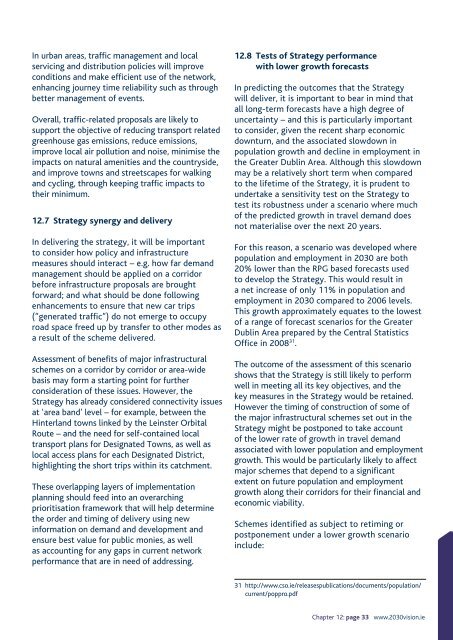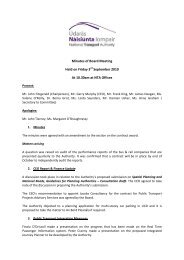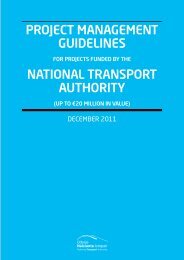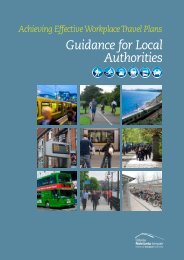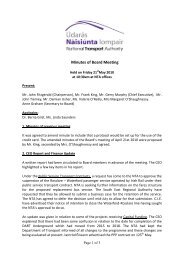Greater Dublin Area Draft Transport Strategy 2011-2030
Greater Dublin Area Draft Transport Strategy 2011-2030
Greater Dublin Area Draft Transport Strategy 2011-2030
- No tags were found...
Create successful ePaper yourself
Turn your PDF publications into a flip-book with our unique Google optimized e-Paper software.
In urban areas, traffic management and localservicing and distribution policies will improveconditions and make efficient use of the network,enhancing journey time reliability such as throughbetter management of events.Overall, traffic-related proposals are likely tosupport the objective of reducing transport relatedgreenhouse gas emissions, reduce emissions,improve local air pollution and noise, minimise theimpacts on natural amenities and the countryside,and improve towns and streetscapes for walkingand cycling, through keeping traffic impacts totheir minimum.12.7 <strong>Strategy</strong> synergy and deliveryIn delivering the strategy, it will be importantto consider how policy and infrastructuremeasures should interact – e.g. how far demandmanagement should be applied on a corridorbefore infrastructure proposals are broughtforward; and what should be done followingenhancements to ensure that new car trips(”generated traffic”) do not emerge to occupyroad space freed up by transfer to other modes asa result of the scheme delivered.Assessment of benefits of major infrastructuralschemes on a corridor by corridor or area-widebasis may form a starting point for furtherconsideration of these issues. However, the<strong>Strategy</strong> has already considered connectivity issuesat ‘area band’ level – for example, between theHinterland towns linked by the Leinster OrbitalRoute – and the need for self-contained localtransport plans for Designated Towns, as well aslocal access plans for each Designated District,highlighting the short trips within its catchment.These overlapping layers of implementationplanning should feed into an overarchingprioritisation framework that will help determinethe order and timing of delivery using newinformation on demand and development andensure best value for public monies, as wellas accounting for any gaps in current networkperformance that are in need of addressing.12.8 Tests of <strong>Strategy</strong> performancewith lower growth forecastsIn predicting the outcomes that the <strong>Strategy</strong>will deliver, it is important to bear in mind thatall long-term forecasts have a high degree ofuncertainty – and this is particularly importantto consider, given the recent sharp economicdownturn, and the associated slowdown inpopulation growth and decline in employment inthe <strong>Greater</strong> <strong>Dublin</strong> <strong>Area</strong>. Although this slowdownmay be a relatively short term when comparedto the lifetime of the <strong>Strategy</strong>, it is prudent toundertake a sensitivity test on the <strong>Strategy</strong> totest its robustness under a scenario where muchof the predicted growth in travel demand doesnot materialise over the next 20 years.For this reason, a scenario was developed wherepopulation and employment in <strong>2030</strong> are both20% lower than the RPG based forecasts usedto develop the <strong>Strategy</strong>. This would result ina net increase of only 11% in population andemployment in <strong>2030</strong> compared to 2006 levels.This growth approximately equates to the lowestof a range of forecast scenarios for the <strong>Greater</strong><strong>Dublin</strong> <strong>Area</strong> prepared by the Central StatisticsOffice in 2008 31 .The outcome of the assessment of this scenarioshows that the <strong>Strategy</strong> is still likely to performwell in meeting all its key objectives, and thekey measures in the <strong>Strategy</strong> would be retained.However the timing of construction of some ofthe major infrastructural schemes set out in the<strong>Strategy</strong> might be postponed to take accountof the lower rate of growth in travel demandassociated with lower population and employmentgrowth. This would be particularly likely to affectmajor schemes that depend to a significantextent on future population and employmentgrowth along their corridors for their financial andeconomic viability.Schemes identified as subject to retiming orpostponement under a lower growth scenarioinclude:31 http://www.cso.ie/releasespublications/documents/population/current/poppro.pdfChapter 12: page 33 www.<strong>2030</strong>vision.ie


